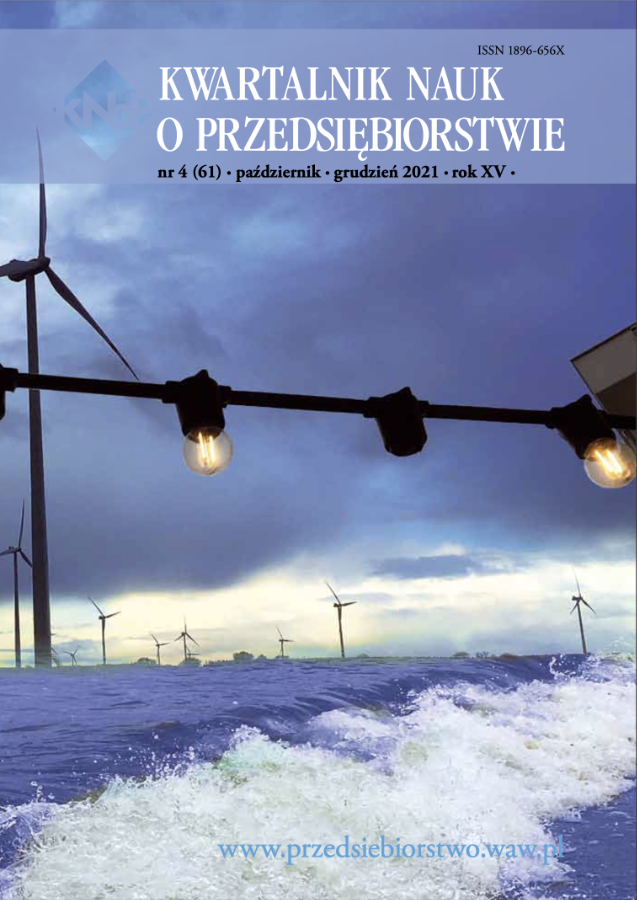Awareness of the green bond market on Polish corporate bonds
Abstract
Investments related to sustainable development are usually of a long-term nature. Providing adequate capital is necessary to be able to implement them. One of the interesting financial instruments capable of meeting these expectations are the so-called Green bonds. The first green bond was called a “climate bond” and was issued by the European Investment Bank (EIB) in 2007. From that moment on, the market began to develop, and Poland has made a significant contribution to the development of the green bond market, as it became the first country to issue green government bonds in December 2016. The aim of the article is to examine the awareness and plans for green bonds among bond issuers who introduced traditional corporate bonds to trading on the Catalyst market. This goal will be achieved through a survey of bond issuers listed on the Catalyst market. The analysis showed that issuers are increasingly confronted with the issue of ESG and want to implement its assumptions into their development strategy, and in addition, most of the respondents will want to issue green bonds in the future, what can popularize this financial instrument.
Full text article
References
2. Brzozowska K. (2017), Sustainable Development Idea in the Bond Market, Prace Naukowe Uniwersytetu Ekonomicznego we Wrocławiu, 478, s. 70-80, https://doi.org/10.15611/pn.2017.478.06
3. Elhers T., Packer F. (2017), Green bond finance and certification, “BIS Quarterly Review”, September, s. 89-104.
4. Febi W., Schäfer D., Stephan A., Sun C. (2018), The impact of liquidity risk on the yield spread of green bonds, “Finance Research Letters”, 27, s. 53-59, https://doi.org/https://doi.org/10.1016/j.frl., 2018.02.025
5. Flammer C. (2021), Corporate green bonds, “Journal of Financial Economic”, https://doi.org/10.1016/j.jfineco, 2021.01.010.
6. Gianfrate G., Peri M. (2019), The green advantage: Exploring the convenience of issuing green bonds, “Journal of Cleaner Production”, 2019, s. 127-135, https://doi.org/https://doi.org/10.1016/j.jclepro, 2019.02.022
7. Gormus A., Nazlioglu S., Soytas U. (2018), High-yield bond and energy markets,”Energy Economic”, s. 69, 101-110, https://doi.org/https://doi.org/10.1016/j.eneco 2017.10.037
8. Hachenberg B., Schiereck D. (2018), Are green bonds priced differently from conventional bonds?, “Journal of Asset Management”, 19(6), s. 371-383, https://doi.org/10.1057/s41260-018-0088-5
9. Hyun S., Park D., Tian S. (2020), The price of going green: the role of greenness in green bond markets, “Accounting & Finance”, 60(1), s. 73-95, https://doi.org/https://doi.org/10.1111/acfi.12515
10. Jones R., Baker T., Huet K., Murphy L., Lewis N. (2020), Creating ecological deficit with debt: The practical and political concerns with green bonds, “Geoforum”, 114 (June), s. 49-58, https://doi.org/10.1016/j.geoforum.2020.05.014
11. Kanamura T. (2020), Are green bonds environmentally friendly and good performing assets?, “Energy Economics”, s. 88, 104767, https://doi.org/10.1016/j.eneco.2020.104767
12. Kapraun J., Latino C., Scheins C., Schlag C. (2021), Which Bonds Trade at a Green Bond Premium?, https://www.bundesbank.de/de/publikationen/berichte/monatsberichte
13. Karpf A., Mandel A. (2018), The changing value of the ‘green’ label on the US municipal bond market, s. 161-165, https://doi.org/10.1038/s41558-017-0062-0
14. Lyon T.P., Maxwell J.W. (2011), Greenwash: Corporate Environmental Disclosure under Threat of Audit,”Journal of Economics & Management Strategy”, 2010, (1), s. 3-41, https://doi.org/https://doi. org/10.1111/j.1530-9134.2010.00282.x
15. Lyon T.P., Montgomery A.W. (2015), The Means and End of Greenwash, Organization & Environment, 28(2), s. 223-249, https://doi.org/10.1177/1086026615575332
16. Maltais A., Nykvist B. (2021), Understanding the role of green bonds in advancing sustainability, “Journal of Sustainable Finance and Investment”, 11(3), s. 233-252, https://doi.org/10.1080/20430795.2020.172 4864
17. Mosionek-Schweda M., Szmelter M. (2018), Zielone obligacje – nowy instrument finansowania inwestycji polskiego rządu, Prace Naukowe Uniwersytetu Ekonomicznego we Wrocławiu, s. 532, 215-224, https://doi.org/10.15611/pn.2018.532.21
18. Nanayakkara M., Colombage S. (2019), Do investors in Green Bond market pay a premium? Global evidence, “Applied Economics”, 51(40), s. 4425-4437, https://doi.org/10.1080/00036846.2019.1591611
19. Petrova A. (2016), Green Bonds: Lower Returns or Higher Responsibility?, Radboud University, Nijmegen School of Management, Master Thesis, s. 1-47.
20. Pham L. (2016), Is it risky to go green? A volatility analysis of the green bond market, “Journal of Sustainable Finance & Investment”, 6(4), s. 263-291, https://doi.org/10.1080/20430795.2016.1237244
21. Reboredo J.C. (2018), Green bond and financial markets: Co-movement, diversification and price spillover effects, “Energy Economics”, 74, s. 38-50, https://doi.org/https://doi.org/10.1016/j.eneco.2018.05.030
22. Tang D.Y., Zhang Y. (2020), Do shareholders benefit from green bonds?, “Journal of Corporate Finance”, December 2020, vol. 61, 101427, https://doi.org/10.1016/j.jcorpfin.2018.12.001
23. Tolliver C., Keeley A.R., Managi S. (2020), Policy targets behind green bonds for renewable energy: Do climate commitments matter, “Technological Forecasting and Social Change”, s. 157 (October 2019), 120051, https://doi.org/10.1016/j.techfore.2020.120051
24. Więckowska M. (2013), The role bonds in financing climate resilient economy, “Copernican Journal of Finance & Accounting”, 2(1), https://doi.org/10.12775/cjfa.2013.011
Authors
The author of the article declares that the submitted article does not infringe the copyrights of third parties. The author agrees to subject the article to the review procedure and to make editorial changes. The author transfers, free of charge, to SGH Publishing House the author's economic rights to the work in the fields of exploitation listed in the Article 50 of the Act of 4 February 1994 on Copyright and Related Rights – provided that the work has been accepted for publication and published.
SGH Publishing House holds economic copyrights to all content of the journal. Placing the text of the article in a repository, on the author's home page or on any other page is allowed as long as it does not involve obtaining economic benefits, and the text will be provided with source information (including the title, year, number and internet address of the journal).

